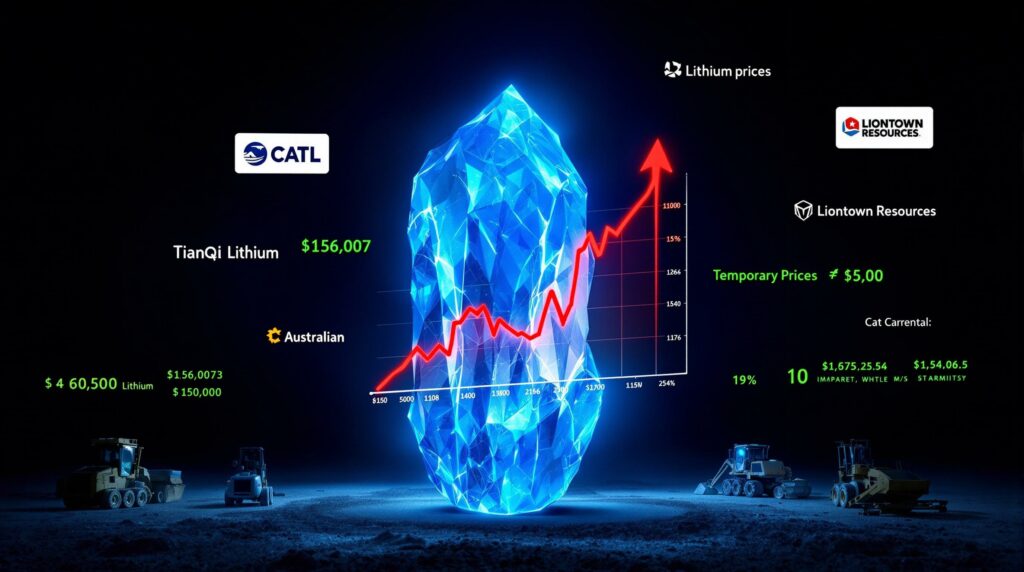Why Are Lithium Prices Suddenly Surging?
Lithium markets experienced a significant jolt in August 2025, breaking a long-running downward trend with a sudden price surge that caught many analysts by surprise. This remarkable shift comes after nearly two years of persistent price declines that had severely impacted the entire battery metals supply chain.
The CATL Mine Suspension Explained
Contemporary Amperex Technology Co. Ltd. (CATL), the world's largest battery manufacturer, has suspended operations at its Jianxiawo lithium mine in China's Jiangxi province. This sudden halt in production represents a significant disruption to global lithium supply chains.
The shutdown occurred after the company's mining license expired on August 9, 2025, triggering immediate concerns about supply constraints in an already volatile market. According to official company statements, CATL has confirmed the suspension will last at least three months while they navigate the bureaucratic process of applying for license renewal.
In its official statement to investors, CATL emphasized that operations would resume "as soon as possible" after obtaining the renewed permit, though market analysts remain skeptical about the exact timeline given China's increasingly complex mining regulations.
Immediate Market Reaction to the Closure
The market response was swift and dramatic. Lithium futures on the Guangzhou Futures Exchange jumped 8% (the daily limit) immediately following the announcement, marking the most significant single-day price movement in over 18 months. The November lithium carbonate contract rose to 81,000 yuan per ton from 75,000 yuan, reflecting renewed market optimism.
This price movement is particularly noteworthy as it represents the first significant upward price catalyst after lithium's nearly 90% price collapse from its 2022 highs. For perspective, lithium carbonate prices had peaked at over 590,000 yuan per ton in November 2022 before beginning their prolonged descent.
Market analysts note this sudden price reversal as potentially signaling a long-awaited bottom in the lithium market, though many remain cautious about declaring a full recovery. The price jump represents the first positive momentum after months of continuous decline that had forced producers worldwide to slash production targets and reconsider expansion plans.
How Are Lithium Stocks Responding to the News?
The ripple effects from CATL's mine closure quickly spread through global equity markets, triggering significant movements in lithium-focused stocks across multiple exchanges. The coordinated nature of these stock movements highlights the interconnectedness of the global lithium supply chain.
Chinese Lithium Producers See Dramatic Gains
Chinese lithium producers, positioned closest to the supply disruption, experienced the most dramatic market gains:
- Tianqi Lithium Corporation shares surged up to 19% in Hong Kong trading, marking their largest single-day gain since March 2023
- Ganfeng Lithium Group experienced a 14% jump in share price, reclaiming significant ground lost during the 2024 downturn
- CATL's own shares rose by 2.8% in Hong Kong despite the production disruption, as investors calculated that broader market benefits would outweigh company-specific challenges
- Zijin Mining Group, with significant lithium assets in its portfolio, saw shares climb 11.6%
These dramatic gains underscore the market's positive interpretation of the mine closure as a potential catalyst for broader supply discipline in the oversupplied lithium market.
Australian Lithium Miners Experience Similar Upswing
The positive sentiment quickly spread to Australian lithium producers, who have been particularly hard-hit by the prolonged price decline:
- PLS Ltd. (formerly Pilbara Minerals) jumped as much as 19% in Sydney trading, erasing several months of losses in a single session
- Liontown Resources saw the largest percentage gain, surging up to 25% as investors reassessed the company's production outlook
- Mineral Resources shares climbed as much as 14%, reinforcing the company's recent strategic pivot back toward lithium assets
- Core Lithium and Sayona Mining each gained over 16%, with trading volumes exceeding three-month averages
This coordinated rally across Australian producers suggests investors view the CATL shutdown as a positive industry-wide catalyst rather than a company-specific event, potentially signaling a turning point for the battered sector. Recent Australian lithium tax breaks have also boosted confidence in the region's mining industry.
What's Behind the Lithium Market's Recent Struggles?
To understand the significance of the CATL mine closure, it's essential to examine the challenging market conditions that have plagued lithium producers for the past 18-24 months. The sector has faced a perfect storm of negative factors that have severely depressed prices.
The Perfect Storm of Oversupply and Underwhelming Demand
Global lithium prices have collapsed nearly 90% from their 2022 record highs, creating significant financial pressure across the entire supply chain. This price decline stems from multiple factors:
- Aggressive capacity expansion: During the 2021-2022 price boom, producers rapidly expanded mining and refining capacity, bringing substantial new supply online
- Production efficiency improvements: Technological advances in lithium mining have reduced extraction costs and increased yields at existing operations
- Slowing EV sales growth: Electric vehicle demand, while still growing, has expanded at a slower rate than projected in industry forecasts
- Economic uncertainty: Global macroeconomic challenges have dampened consumer appetite for premium-priced electric vehicles
This combination has forced lithium producers worldwide to delay expansions and reduce capital expenditures. Major projects across Australia, South America, and North America have been placed on hold, with companies prioritizing cash preservation over growth.
China's Role in the Lithium Supply Chain
China has emerged as the dominant force in global lithium processing and refining, giving it outsized influence over market prices. The country's strategic approach to battery metals has several key components:
- China controls over 60% of global lithium processing capacity
- The country's Yichun region has developed into a major battery metals hub with dozens of mines
- Chinese production capacity expanded rapidly during the 2021-2022 lithium price boom
- State-backed companies invested heavily in overseas lithium assets to secure supply chains
This expansion contributed significantly to the current supply glut conditions. Chinese producers have been reluctant to cut production despite falling prices, creating a challenging market dynamic where individual companies have limited incentive to reduce output unless competitors do the same.
Will This Trigger Broader Production Cuts in China?
The CATL mine suspension could represent just the beginning of a broader realignment in Chinese lithium production. Several factors suggest additional production curtailments may follow in the coming months.
Potential for Wider Mining Restrictions
Market attention has shifted to other mining operations around China's Yichun city, where regulatory scrutiny appears to be intensifying:
- A local government department has requested eight additional miners to submit reserves reports by September 30, 2025
- This follows an audit that uncovered non-compliance issues in registration and approvals processes
- Several mines have already begun proactively reducing production in anticipation of potential regulatory actions
- Industry insiders suggest as much as 15-20% of Yichun's lithium production could be temporarily halted
These administrative reviews could lead to additional production suspensions, potentially removing significant supply from the market. Notably, Yichun's mines are generally smaller operations with less stringent environmental controls than CATL's facilities, potentially making them more vulnerable to regulatory intervention.
Expert Perspectives on Market Impact
Industry analysts offer mixed perspectives on the long-term implications of these developments:
"Prices may deviate from reasonable levels in the short term, but CATL's situation does not change the oversupply structure in the market," notes Zhang Weixin, analyst at China Futures Co. However, Zhang adds that "if production disruption is expanded to other mines in Yichun after Sept. 30, the lithium price level could go even higher."
Citigroup analysts indicate the suspension alone won't create a market deficit but will "bolster sentiment in the short term." Their analysis suggests approximately 6,000-8,000 tonnes of lithium carbonate equivalent (LCE) production could be affected by the CATL shutdown.
The consensus view among experts suggests temporary price support rather than a fundamental market reversal, though the situation remains fluid as regulatory developments continue to unfold. Meanwhile, in the United States, the Thacker Pass mine update shows progress on diversifying global lithium supply.
How Does This Fit Into China's Broader Economic Strategy?
The lithium production cuts appear to align with larger economic policy shifts in China, suggesting potential coordination between regulatory actions and broader industrial policy objectives.
Beijing's Crackdown on Industrial Overcapacity
The lithium production cuts align with China's broader economic policy to address overcapacity across multiple sectors:
- Chinese authorities have implemented similar measures in steel, aluminum, and solar panel manufacturing
- These policies aim to rationalize production and stabilize prices in oversupplied markets
- Central government directives have increasingly emphasized "high-quality development" over raw production volume
- Local officials face growing pressure to enforce environmental and safety regulations
This approach represents a shift from previous years' emphasis on rapid capacity expansion at all costs. Policymakers appear increasingly willing to accept short-term production disruptions to achieve longer-term market stability.
Balancing Environmental and Economic Objectives
Mining permit reviews provide an opportunity to enforce environmental compliance standards that have often been overlooked during periods of rapid growth:
- China has been strengthening environmental regulations across its mining sector
- Water usage and contamination concerns have become particularly prominent in lithium mining regions
- Local communities have increasingly voiced concerns about environmental impacts
- The government appears to be using administrative measures rather than direct market intervention
This approach allows authorities to address multiple policy objectives simultaneously, including environmental protection, supply chain security, and market stabilization. By focusing on regulatory compliance rather than imposing explicit production quotas, officials can achieve supply discipline while maintaining market principles.
What Should Investors Watch For Next?
As the lithium market digests these developments, several key indicators will determine whether this represents a temporary price blip or the beginning of a sustained recovery.
Key Indicators to Monitor
Investors should keep close watch on several critical developments in the coming months:
- Regulatory Timelines: The September 30 deadline for Yichun miners to submit reserves reports
- Production Announcements: Any announcements regarding additional mine suspensions or permit reviews
- CATL's Resumption Schedule: The company's timeline for resuming operations at the Jianxiawo mine
- Policy Signals: Changes in Chinese government policy regarding lithium production capacity
- Inventory Levels: Lithium carbonate and hydroxide inventory levels at major Chinese ports and processing facilities
These indicators will provide early signals about whether the production cuts represent a short-term disruption or a more fundamental shift in market dynamics.
Long-Term Market Outlook Considerations
Beyond immediate price movements, several structural factors will shape the lithium market's trajectory:
- Supply Rationalization: Whether the production cuts will be sufficient to meaningfully reduce global oversupply
- Demand Recovery: Electric vehicle adoption rates in major markets like China, Europe, and North America
- Project Pipeline: Development timelines for new lithium projects outside China, particularly in Australia and South America
- Technological Evolution: Potential technological changes affecting lithium demand intensity in batteries, including shifts toward sodium-ion alternatives
Industry analysts suggest the lithium market may require 12-18 months of supply discipline before a sustainable price recovery can take hold, assuming demand continues to grow at current rates. Meanwhile, innovative approaches like geothermal lithium extraction are being developed to diversify supply sources.
FAQ: Understanding the Lithium Market Situation
Why is the CATL mine suspension significant for lithium prices?
CATL is the world's largest battery manufacturer, and its mining operations represent a meaningful portion of Chinese lithium supply. The Jianxiawo mine produces approximately 13,000 tonnes of lithium carbonate equivalent annually, accounting for roughly 2-3% of China's domestic production.
The suspension signals potential broader production discipline in a severely oversupplied market, giving investors hope that the prolonged price decline might finally be addressed through supply-side adjustments. More importantly, it suggests regulatory authorities may be taking a more active role in managing the country's lithium production capacity.
Could this mark the beginning of a lithium price recovery?
While the immediate market reaction has been positive, most analysts remain cautious about declaring a full market reversal. The fundamental oversupply conditions persist, with global lithium production capacity still exceeding demand by approximately 100,000-150,000 tonnes in 2025.
One mine suspension alone is unlikely to rebalance the market. However, if this represents the beginning of broader production discipline across Chinese producers, it could establish a price floor and potentially support gradual recovery. The market will likely require multiple quarters of coordinated production restraint before a sustainable uptrend can develop.
How might this affect electric vehicle manufacturers?
In the short term, the impact on EV manufacturers should be minimal, as lithium prices remain significantly below their 2022 peaks despite this recent increase. Current lithium carbonate prices of approximately 81,000 yuan per tonne ($11,300 USD) represent just a fraction of the nearly 600,000 yuan per tonne seen at the market peak.
If additional production cuts follow and prices rise substantially, it could eventually pressure battery and EV costs, but this would likely take several months to materialize in the supply chain. Most major EV manufacturers have secured long-term supply agreements that provide some insulation from short-term price fluctuations.
For consumers, the price impact would be negligible in the near term, as lithium typically represents only 5-8% of a battery's total cost, which itself accounts for roughly 30-40% of an electric vehicle's production cost. Additionally, the development of a battery-grade lithium refinery in India suggests global processing capacity continues to diversify.
Disclaimer: This article contains market analysis and forward-looking statements regarding lithium prices and stock performance. These views represent opinions based on current information and should not be considered investment advice. All investments carry risk, and past performance is not indicative of future results. Readers should conduct their own research and consult financial advisors before making investment decisions.
Further Resources for Lithium Market Followers
Investors and industry participants seeking to deepen their understanding of lithium market dynamics may benefit from these additional considerations:
- Supply Chain Complexity: The lithium supply chain involves multiple processing steps from mining to battery-grade materials, each with different market dynamics
- Geopolitical Factors: Growing resource nationalism in lithium-producing regions can impact production decisions beyond pure market economics
- Contract Structures: The difference between spot prices and long-term contract prices often creates disconnects between market headlines and company financial performance
- Technological Disruption: Ongoing research into lithium alternatives and recycling technologies may fundamentally alter long-term supply-demand dynamics
As the energy transition accelerates, lithium prices and stocks jump after CATL halts major China mine operations will likely remain a topic of significant interest, creating both challenges and opportunities for companies and investors throughout the battery metals supply chain.
Want to Stay Ahead of Major ASX Mining Discoveries?
Discovery Alert's proprietary Discovery IQ model provides instant notifications on significant ASX mineral discoveries, turning complex data into actionable investment insights. Explore historic returns from major discoveries and gain your market-leading advantage by visiting the dedicated discoveries page.




